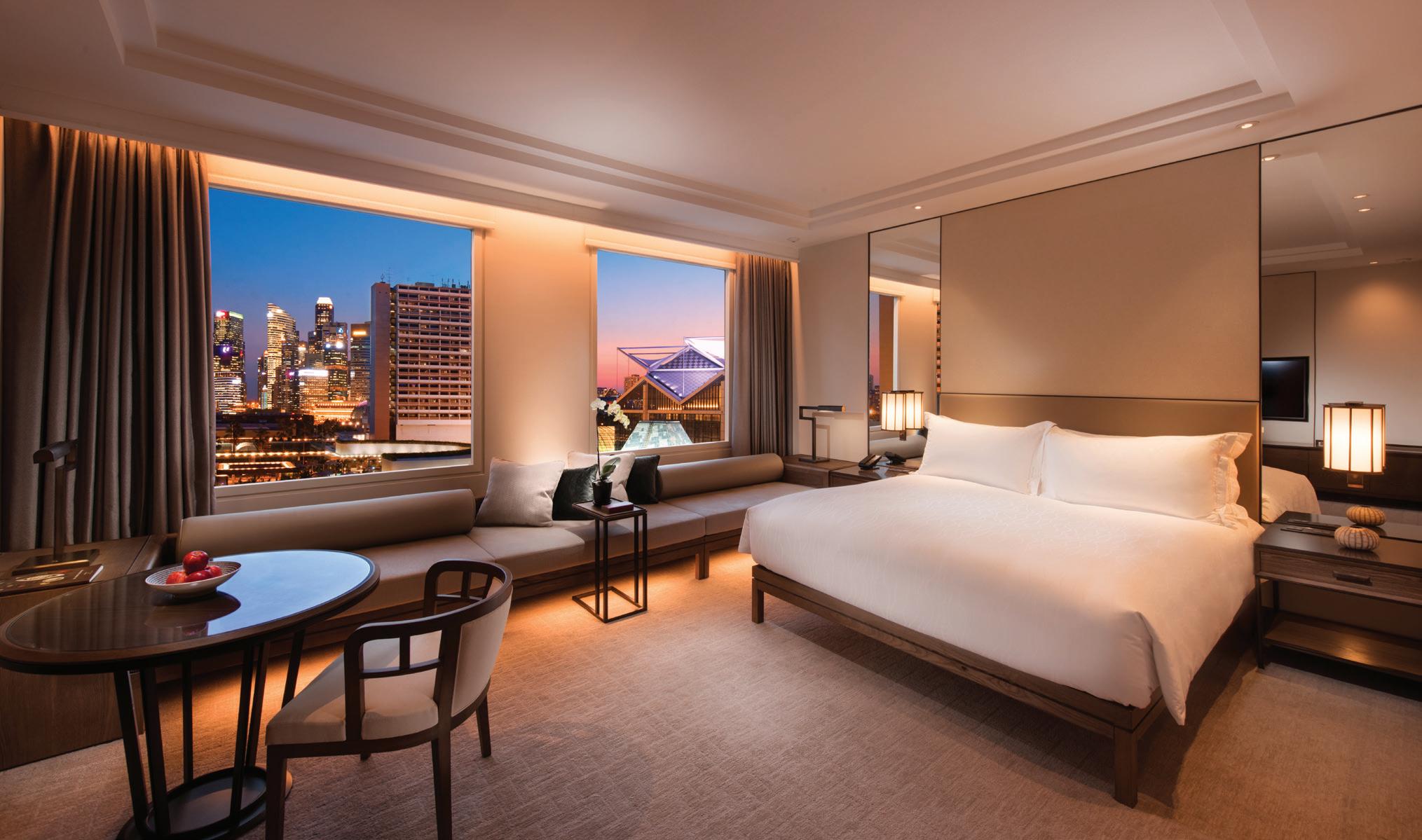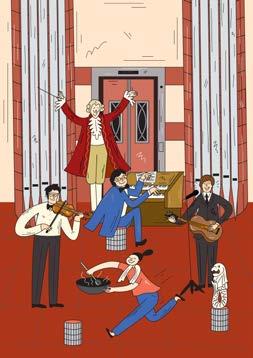SCHUMANN QUARTET
10 May Schumann Quartet – Debussy, Janáček & Brahms

11 May Schumann Quartet – Brahms & Beethoven
Victoria Concert Hall

10 May Schumann Quartet – Debussy, Janáček & Brahms

11 May Schumann Quartet – Brahms & Beethoven
Victoria Concert Hall
The Schumann Quartet has reached a stage where anything is possible, because it has dispensed with certainties. This also has consequences for audiences, which from one concert to the next have to be prepared for all eventualities: “A work really develops only in a live performance,” the quartet says. “That is ‘the real thing’, because we ourselves never know what will happen. On the stage, all imitation disappears, and you automatically become honest with yourself. Then you can create a bond with the audience – communicate with it in music.” This live situation will gain an added energy in the near future: Sharon Kam, Fabian Müller, Anna Lucia Richter, Anna Vinnitskaya, und Jörg Widmann are among the quartet’s current partners.

A special highlight of the 22/23 season will be a concert tour to Singapore, followed by concerts in Adelaide, Australia. The quartet will also perform twice at the Concertgebouw Amsterdam and
three times at the Wigmore Hall in London. In Europe, the quartet will embark on a major tour with Anna Vinnitskaya in April 2023, during which they will perform Robert Schumann’s Piano Quintet in Brussels, Hamburg, Berlin, Geneva and elsewhere. Not to forget the ensemble’s return to very familiar venues such as the Mozartfest Würzburg and the Schubertiade in Schwarzenberg/Hohenems.
Its album “Intermezzo” (2018 | Mendelssohn Bartholdy, Schumann und Reimann with Anna-Lucia Richter) has been hailed enthusiastically both at home and abroad and received the award “Opus Klassik” in the category quintet. It is celebrated as a worthy successor to its awardwinning “Landscapes” album, in which in which the quartet traces its own roots by combining works of Haydn, Bartók, Takemitsu and Pärt. Among other prices, the latter received the “Jahrespreis der deutschen Schallplattenkritik”, five Diapasons and was selected as Editor’s Choice
by the BBC Music Magazine. For its previous CD “Mozart Ives Verdi”, the Schumann Quartet was accorded the 2016 Newcomer Award at the BBC Music Magazine Awards in London. In 2020 the quartet has expanded its discography with “Fragment” and his examination of one of the masters of the string quartet: Franz Schubert. On the occasion of the 100th anniversary of the radio, the quartet will dedicate itself to a very special project: An album of pieces around and from 1923. Together with the Bavarian Radio, they will record works by Alban Berg, Leoš Janáček, Ernst Krenek and Aaron Copland.
The three brothers Mark, Erik and Ken Schumann have been playing together since their earliest childhood – meanwhile violist Veit Hertenstein completes the quartet. The four musicians enjoy the way they communicate without words. Although the individual personalities clearly manifest themselves, a common space arises in every musical work in a process of spiritual metamorphosis. The quartet’s openness and curiosity may be partly the result of the formative influence exerted on it by teachers such as Eberhard Feltz, the Alban Berg Quartet, or partners such as Menahem Pressler.
Awards, CD releases – it is always tempting to speculate on what factors have led to many people viewing the Schumann Quartet as one of the best in the world. But the four musicians themselves regard these stages more as encounters, as a confirmation of the path they have taken. They feel that their musical development over
the past two years represents a quantum leap. “We really want to take things to extremes, to see how far the excitement and our spontaneity as a group take us,” says Ken Schumann, the middle of the three Schumann brothers. They charmingly sidestep any attempt to categorise their sound, approach or style, and let the concerts speak for themselves.
And the critics approve: “Fire and energy. The Schumann Quartet plays staggeringly well [...] without doubt one of the very best formations among today’s abundance of quartets, […] with sparkling virtuosity and a willingness to astonish” (Harald Eggebrecht in Süddeutsche Zeitung).
PROGRAMME
Schumann Quartet*
Musicians of the SSO
DEBUSSY
Danses sacrée et profane for Harp & Strings
Gulnara Mashurova harp Velt Hertenstein viola*
Erik Schumann violin* Marietta Ku viola
Zhang Si Jing violin Alexey Stadler cello*
Ken Schumann violin* Jamshid Saydikarimov cello
Sayuri Kuru violin Yang Zhengyi double bass
11 mins
JANÁČEK
String Quartet No. 1 “Kreutzer Sonata”
Erik Schumann violin* Velt Hertenstein viola*
Ken Schumann violin* Alexey Stadler cello*
18 mins
20 mins
BRAHMS
String Sextet No. 1 in B-flat major, Op. 18
Erik Schumann violin* Yang Shi Li viola
Ken Schumann violin* Alexey Stadler cello*
Velt Hertenstein viola* Wang Yan cello
36 mins
CONCERT DURATION: approximately 1 hour and 30 mins (with 20 mins intermission)
Danses sacrée et profane for Harp & Strings
In 1894 the French piano maker Pleyel had just invented a chromatic harp which, because of an extra set of strings, removed the need for pedals. As part of their marketing for the instrument the firm commissioned Debussy to write a piece showing off the instrument’s capabilities. Of course, Debussy could have created something purely functional, but his Danses sacrée et profane has gone on to become one of his most admired works.
The ‘sacred’ and ‘profane’ labels of the title are perhaps better understood as ‘spiritual’ and ‘earthly’. The first of the two dances has an air of ancient religiosity and recalls medieval chants in the string melodies under the harp’s glistening melody. The composer himself once noted the ‘gravity’ of the opening dance in a letter to fellow composer Manuel de Falla. By contrast, the composer pointed to the ‘grace’ of the second of the two dances. His exploration of the ‘profane’ – the earthly, the secular, the sensual – is a lilting waltz which nods to the lively music of the Mediterranean, particularly Spain. It seems that Debussy was sceptical about the potential of Pleyel’s new instrument, and indeed the company ceased production of the chromatic harp by 1930. Happily – as we’ll hear in this concert – the piece can be performed on pedal harp or even piano.
Programme note by Elizabeth Davis
String Quartet No. 1 “Kreutzer Sonata”
I. Adagio – Con moto
II. Con moto
III. Con moto – Vivo – Andante
IV. Con moto – (Adagio) – Più mosso
Janáček’s first string quartet is a curious case of cross-pollination in various art forms: it is a sonata (for string quartet), based on a book, based on a sonata! The composer was inspired after reading Tolstoy’s novella “The Kreutzer Sonata”, which was in turn inspired by Beethoven’s 9th violin sonata, named after its dedicatee Rodolphe Kreutzer. Earlier sketches of some of the music show that Janáček had conceived a piano trio (now lost), and music from that trio turned into this string quartet.
The Europe of 1923 was reeling from years of violence from the Great War, and the idea of suffering permeates this composition. Janáček imagined a poor woman like the one from Tolstoy’s book, and the music paints a psychological drama: the opening few seconds lays out a slow rising-falling motif followed by a Moravian folk tune (“Šohajíčku, čí si” — “Dear young man, whose are you?”), and these two ideas alternate throughout the movement, with some very unyielding repetition. More lyrical moments show the type of melodic writing that Janáček was famous for: based on long years of studying speech patterns, his melodies closely shadow the speech patterns of the Czech language. (Look for falling 4ths and 5ths at the ends of phrases, as well as quick falling fragments.)
The second movement is also similarly dry in tone, with scratchy sul ponticello effects from the string players, where they play with their bows close to or on the bridge. Short melodic fragments get passed around all four players and the middle point of the movement introduces a strangely angular chorale. There is deep unease throughout, and even if there is a quiet ending, violence is never far from the surface. The third movement demonstrates this as well, with calmer soloistic moments interrupted by violent sawing from the ensemble. Outbursts of plucked strings and syncopated rhythms bring more darkness, and even in the final movement, there is little peace to be had.
String Sextet No. 1 in B-flat major, Op. 18
I. Allegro ma non troppo
II. Andante, ma moderato
III. Scherzo: Allegro molto
IV. Rondo: Poco allegretto e graziso
From these later masters we turn to Brahms, whose early essay in the genre came only after he had established his compositional credentials with several large piano works and obtained the blessings of Robert Schumann. It is not often performed, and the obvious choice when programming a German string sextet falls to Schoenberg’s echt-
Romantic Transfigured Night. Brahms succumbs to the German propensity for profundity here, with very thick writing, but he had Joseph Joachim (the eventual dedicatee of the huge Violin Concerto) to advise him with the string writing and even some compositional details.
The expansive three-in-a-bar that the Sextet opens with proved to be an eventual favourite of Brahms. His sensitive use of hemiola and crossrhythm to destabilise the beat had been well learnt from Schumann, and the first movement abounds in themes that allowed him to show off that rhythmic flexibility. The soothing melodies of the cello give way to a flowing triplet accompaniment (another Brahms favourite). Brahms’s penchant for playing the lower strings off the violins, as he does in the symphonies, are evident here, and he juggles thematic fragments across all six players with great skill.
Brahms loved the theme and variation form deeply, and here, in the slow movement, the unwinding of a serious theme into a deeply-felt dramatic buildup before the warmth of the major key shines through demonstrates a master at work. This movement nods towards Beethoven, another musical hero of his, and certainly the Scherzo does too: the rustic flavour recalls the equivalent passage from Beethoven’s 5th Symphony.
Joachim remained of the opinion that Brahms’s final movement was a little too indebted to Schubert (even going so far as to call the ending a bit weak), and indeed it could almost be a re-instrumentation of a Schubert rondo. But a composer being able to imitate musical models is no real fault, and indeed, the charm of the cello theme is undeniable. Brahms, humble as always, called this work “trash” in a letter to Clara Schumann, and wrote that she should burn it; it is a good thing she was much more lenient with his work than she was with Robert’s!
Programme notes by Thomas Ang


Schumann Quartet*
Musicians of the SSO
BRAHMS
String Quartet No. 3 in B-flat major, Op. 67
Erik Schumann violin*
Ken Schumann violin*
Velt Hertenstein viola*
Alexey Stadler cello*
BEETHOVEN
Septet in E-flat major, Op. 20
Erik Schumann violin*
Velt Hertenstein viola*
Alexey Stadler cello*
Jacek Mirucki double bass
Ma Yue clarinet
Zhao Ying Xue bassoon
Marc-Antoine Robillard French horn
CONCERT DURATION: approximately 1 hour and 45 mins (with 20 mins intermission)
String Quartet No. 3 in B-flat major, Op. 67
I. Vivace
II. Andante
III. Agitato (Allegretto non troppo)
IV. Poco allegretto con variazioni
Brahms, who held his first two string quartets from publication while he revised them for almost 20 years, had no problems with his third. He had turned to this string quartet to relieve his musical mind from the profound turbulences of his 1st symphony. He noted that he had tried to compose several smaller “trifles” so as not to look at any more symphonic monuments for a while, and in his usual self-critical manner, this quartet was among those “trifles”.
But what a trifle it is! The happy mood at the outset harks back to Haydn, and the humour in the first movement is a good sense of this: the instruments play with different time signatures at various points, sounding like dancers trying to choose a dance to do together. The slow movement is full and lyrical, Brahms at his best. It is of course not without contrast, and the interruptions are fully dramatic moments, almost symphonic in nature. Both middle movements are very typical Brahms at his most innig, with deeply felt melody and harmony. His tactic of leaving the viola unmuted in the third movement while the others dampen their sound produces a haunting mid-heavy sonority, which he described as “the tenderest” movement he had ever written.
The finale is a set of variations, and the viola remains prominent here. One of the musical forms that Brahms loved, these eight variations unfold with great poise, eventually resulting in a 6/8 that is firmly related to the opening of the whole quartet nearly half an hour back. This composerly sleight-of-hand gives the work a tight sense of unity, and Brahms would always look back on Op. 67 as the favourite of his three quartets: filled with inspiration, real sentiment, and a great joy, it has remained a firm concert favourite since.
(1770 – 1827)
Septet in E-flat major, Op. 20
I. Adagio – Allegro con brio
II. Adagio cantabile
III. Tempo di menuetto
IV. Tema con variazoni: Andante
V. Scherzo: Allegro molto e vivace
VI. Andante con moto alla marcia – Presto
Beethoven’s one-off Septet is an “occasional” piece of some historical importance, being one of the last works he wrote before he became aware of the onset of his profound hearing loss. Of course, since he did not yet experience the imminent sense of doom which would lead him to the Heiligenstadt testament, the Septet is a light-hearted work in the late-Classical style, resembling a Mozartean divertimento more than anything else.
Despite its colourful forces of a string quartet augmented by clarinet, bassoon, and horn, the work is ultimately conservative, and despite that, it was immediately popular and remained so during his lifetime, often eclipsing his more serious music. Even though he dedicated it to the Empress Maria Theresa, he would actually come to hate it, even wishing later in his life that he had destroyed the score. Before such regrets, though, he had already rearranged the music as a trio for clarinet, cello, and piano, and dedicated that arrangement to a friend of his.
The music is as graceful and elegant as anything that could have been written in 1799, at a time when every composer who wanted to make a name was writing serenades and
divertissements for the European aristocracy. Beethoven’s is a class apart, however, and his skill in assigning dialogues to the various instruments results in a genuinely interesting piece. In particular, the slow movement has a soaring duet between violin and clarinet, and later, when the bassoon takes over the melodic argument, the other instruments leave little comments around it. The minuet and trio that follows is chirpy and pastoral, and the 4th movement is a set of variations on a Rhenish folk tune (“Ach Schiffer, lieber Schiffer” — “Ah captain, dear captain”), showing Beethoven in full country manner.
Hunting calls from the horn and subtle chromaticisms in the harmony make the Scherzo more restless, and indeed the music sounds almost symphonic, with the first violin playing high up before the cello solo takes over in the trio. The dark march that ushers listeners into the final movement is the only truly dramatic music (and much more familiar to regular Beethoven listeners), though the rest of the movement is basically a Haydn symphonic finale. Here, youthful charm shines through, and the mubsic has incredible spring in its step, with the first violin showing off like a soloist!
Programme notes by Thomas Ang

ACOUSTIC SHOCK–AN ORGAN AND ELECTRONIC MUSIC SPECTACULAR


Sun 20 Aug, 4pm
Annie Maria Lim organ Benjamin Ang electronic music producer
TE MOMENTS
Tue 12 Sep, 7.30pm
ed 13 Sep, 7.30pm
Yao Xiao Yun piano Musicians of the SSO
Conversations held in Mandarin only
A HAUNTED WEEN HYMN


Sat 28 Oct, 7.30pm
Sun 29 Oct, 4pm
Singapore Symphony Chorus
Eudenice Palaruan Choral Director Loraine Muthiah organ
BACH’S BRANDENBURG OS PART I , 7.30pm


Singapore Symphony Orchestra w Arthur harpsichord/conductor
ORGAN BAROQUE AL
UNBOXING THE ORGAN WITH DR PHOON YU AND THE LORONG BOYS
Sun 1 Oct, 4pm
Phoon Yu organ
Lorong Boys
CHAMBER
LEONIDAS K AVAKOS IN RECITAL
Sun 15 Oct, 4pm
Leonidas Kavakos violin

Enrico Pace piano
BACH’S BRANDENBURG OS PART II , 7.30pm
Singapore Symphony Orchestra w Arthur harpsichord/conductor
CHAMBER
MOONLIGHT, PATHÉTIQUE AND APPASSIONATA
Sun 10 Dec, 4pm
Rudolf Buchbinder piano
To find out more, please visit www.sso.org.sg

Founded in 1979, the Singapore Symphony Orchestra (SSO) is Singapore’s flagship orchestra, touching lives through classical music and providing the heartbeat of the cultural scene in the cosmopolitan citystate. Our Music Director is Hans Graf. While the SSO performs frequently at the Esplanade Concert Hall, for a more intimate experience, we return to the place of our beginnings, the Victoria Concert Hall (VCH) – the home of the SSO. The VCH is host to our popular Children’s, Family and biannual free Lunchtime Concerts as well as our VCHpresents chamber series.

SUPPORTED BY
VCHpresents
VCHhomeofthesso
sso.org.sg/ VCHpresents